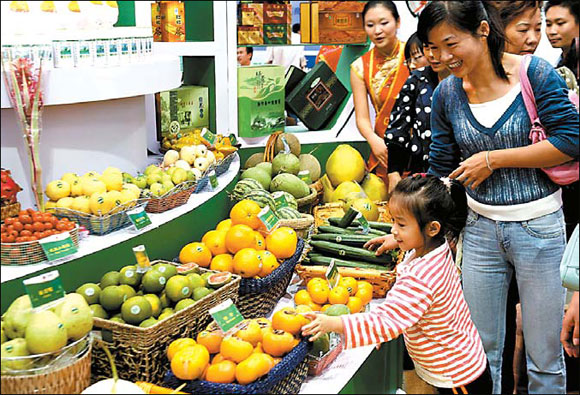


Jack fruit from Vietnam, rambutan from Thailand and durian from Malaysia.
Chinese people are now familiar with finding these tropical fruits in local supermarkets. But most shoppers, particularly residents in northern China, had never heard of them - let alone tasted one - three decades ago. In fact, until 1993 fresh fruits accounted for just roughly 30 percent of China's annual fruit imports and were largely concentrated on bananas, apples and oranges.
Changes emerged as Chinese decision-makers lived up to late leader Deng Xiaoping's expectation of "relying on both domestic and global resources and markets".
China's fresh fruit imports have increased and diversified rapidly since the late 1990s as Chinese enterprises and consumers became increasingly inter-dependent with the rest of the world. Fruits from Southeast Asian neighbors have achieved greater access to the Chinese market since China signed the free trade agreement (FTA) with the ASEAN.
Under the FTA framework signed in November 2002, nations involved must reduce tariffs and remove non-tariff barriers on trade of agricultural products and other goods, and lift limitations on market access for service trade (such as banking and telecommunications) and investment.
China and ASEAN members signed agreements on the free trade of goods in November 2004. They began to take effect in July 2005, and will be completed in 2010 by China and the six ASEAN economies: Indonesia, Malaysia, the Philippines, Singapore, Thailand and Brunei; and in 2015 by the four ASEAN economies: Cambodia, Laos, Vietnam and Myanmar.
"The agreement has largely benefited Chinese consumers - they now spend less on the same products while having multiple choices," says Zhang Kening, an official with department of international trade and economic affairs under the Ministry of Commerce.
Take rambutan imported from ASEAN members, for example. Thanks to the removal of a 20 percent import tax, the price of rambutan in China has now dipped to 48 US cents from 55 US cents in 2004, while import volume jumped to 4,107 tons a year from 2,650 tons, according to the Ministry of Commerce.
Trade of farm products is important but just part of the fast-growing bilateral trade. In the first 11 months of 2007, imports and exports between China and ASEAN reached $182.33 billion, an increase of 25.68 percent from the previous year, according to commerce ministry statistics. ASEAN and China are now each other's fourth largest trading partner.
The free trade pact is also good news for companies eager to reduce export costs or invest overseas with fewer hurdles.
"Enterprises from both sides have saved expenditures, lowered costs and sharpened their competitive edge because of the agreement," Zhang says.
As of last September, Chinese businesses had applied for some 170,000 certificates of origin for favorable tariffs and had exported goods worth $3.25 billion to ASEAN countries.
Chinese firms in the infrastructure and logistics industries, such as rail, airline and port companies, all see golden opportunities in ASEAN.
Discussion of free trade agreements has been heated worldwide. Many nations have turned to bilateral agreements after discovering that multinational negotiations, such as the Doha Round under the World Trade Organization, are overly time-consuming.
A number of countries are now involved in FTA talks that they believe will boost trade and investment.
So far, China has signed FTAs with 14 countries and regions. It is also engaged in negotiations with 12 other countries and regions, and feasibility studies are being conducted with three more.
The establishment of free trade zones is important to China, which relies heavily on trade, says Zhao Jinping, a researcher with the Development Research Center of the State Council.
"It is an efficient way to promote trade growth, one of the three engines driving China's economy. Free trade zones with participating countries offer open markets and few trade barriers," he says.
China-Pakistan FTA
China and Pakistan are expected to wrap up negotiations on a services FTA in the first quarter of this year, Salman Bashir, Pakistan's ambassador to China, told reporters late last month.
It is the latest move in the two countries' efforts to establish a complete free trade zone since they inked a trade in goods agreement in November 2006.
According to the agreement, tariffs on 90 percent of products from China and Pakistan have been or will be removed. It is expected to boost China's textile, chemical, electronic and machinery exports to Pakistan and the nation's imports of Pakistani minerals, aquatic and agricultural products are also set to rise.
The two countries also mapped out a five-year plan for economic cooperation that set a bilateral trade target of $15 billion by 2011.
Bashir called on businesses to take full advantage of the FTA to facilitate investment flows.
China-New Zealand FTA
China and New Zealand recently finished the 15th round of talks toward an FTA.
Breakthroughs have been made during this round after thorough discussion about trade in goods, trade in services and investment, says the commerce ministry's Zhang.
The FTA is expected to be signed by April.
China-Chile FTA
China and Chile signed an FTA on trade in goods in 2005, and the agreement took effect on October 1, 2006.
Chile, China's first FTA partner in Latin America, has experienced robust growth in trade with China since the agreement began. China has surpassed the United States to become Chile's largest trade partner.
China has wiped out tariffs on more than 4,700 goods exported from Chile and has removed duties from about 6,000 goods exported from China. The goods range from chemical products, textiles and clothing to machinery products and parts, and metal and mineral products.
By 2015, more than 97 percent of the two nations' exports will be tariff-free.
Talks on service trade and investment agreements kicked off in January 2007 and are expected to finish within 2008.
(China Daily 01/05/2008 page3)













